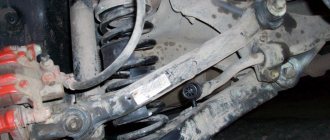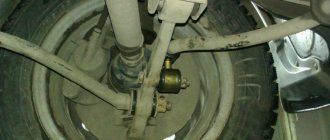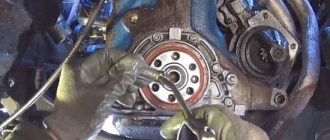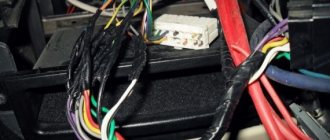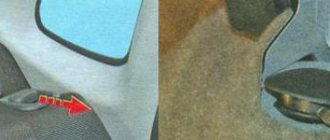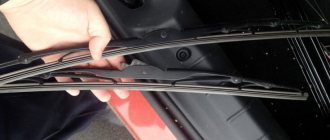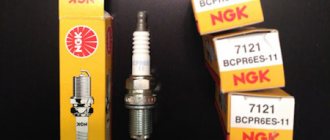Removing the rear suspension strut module on a VAZ 2110-2112
So, when the car is still standing on the ground, you need to slightly loosen the nut securing the rear drain from above, which can be reached from the inside of the car or the trunk. This is what the nut looks like:
While unscrewing the nut, the strut rod must be held so that it does not turn. This can be done using a regular 6 key, or you can use a special one - which is designed for this work.
After this, we tear off the rear wheel mounting bolts, lift the car with a jack or lift and completely remove the wheel from the car. Now we have free access to the lower rear shock absorber mounting bolts. Unscrew the nut with a 19mm wrench, while simultaneously holding the bolt on the reverse side from turning:
And then remove the bolt from the reverse side. It is not always possible to do all this by hand, so you can use either a thin punch and a hammer so as not to damage the thread, or using a wooden block and again a hammer.
Then use a pry bar to pry the stand from below to disengage it. This step of the procedure is shown more clearly in the photo below:
Then you can completely unscrew the upper rack mount. Personally, I got by with a regular open-end wrench and held the rod with a 6 wrench. Although, it is more convenient to do this with a special one:
After which you can remove the entire VAZ 2110-2112 rear suspension module assembly, as shown in the photo:
Removal and installation of springs, boots and bumpers (compression buffers) on VAZ 2110-2112
The spring can now be removed without any problems, since there is nothing holding it in place.
The boot is also easy to remove, just pull it up:
The bump stop, or as it is also called, the compression buffer, is also pulled off the rod without unnecessary difficulties. If necessary, replace all removed parts and install everything in the reverse order.
Prices for struts, rear springs and compression buffers using the example of SS20
Unfortunately, I no longer remember the exact prices, but I can roughly name the range of what costs and how much:
- a pair of rear struts - price about 4500 rubles
- classic springs around 2500 rubles
- compression buffers from SS20 can be purchased for 400 rubles
It is possible that there are some deviations from the above prices, but a little time has passed since I personally bought all this for my car.
Almost every driver, even those far from mechanics and repairs, knows that replacing the rear struts on a VAZ 2110 is carried out when the car unsuccessfully runs into potholes. At the same time, replacing the rear struts on a VAZ 2110 must be carried out competently and using special equipment.
Properties of suspension springs
When torsion bars on vehicles were replaced with springs, handling improved and suspensions became more convenient to maintain. Springs maintain the vehicle's ground clearance, reducing vibrations and shocks while the vehicle is moving.
To make the ride comfortable, you need to choose the right parts. If the technical characteristics are unsuitable, then the positive properties of the suspension will be reduced to zero
Therefore, it is important to consider the following parameters:
- diameter - its increase affects rigidity;
- number of turns - as the number increases, the rigidity decreases;
- form.
Often, car owners strive to install stiffer parts in the suspension. This helps to increase the sensitivity of the steering wheel to the driver's control, but the grip on the road deteriorates.
Fans of a sporty driving style believe that, on the contrary, it is better to install parts with reduced rigidity. However, this suspension can create problems on country roads.
Let's take a closer look at which springs are best installed on a VAZ.
What problem does the rear pillar solve?
A car's pillars, including the front ones, are car components that are designed to absorb body energy transmitted from driving on the road surface. If the road is uneven, then a double load sits on the racks. In fact, not only the comfort of movement, but in many cases also safety depends on the operation of the racks. So:
- In particular, they are responsible for the wear of the car’s chassis, help, together with shock absorbers, to resolve issues with body bouncing, and much more. As is known, at the moment of bouncing, the wheels of the car lose contact with the road surface and temporarily become suspended from transmitting the brake, driving and exerting lateral forces. As a result, all this affects driving safety.
- As for driving comfort, it is lost without high-quality shock absorption, especially if the direction of movement changes when moving over bumps. In addition, when braking or sharply accelerating, every pebble on the road, or rather its energy, is transferred to the cabin, so to speak, without filtering.
Note. The rear pillars, like the front ones, effectively solve the above problems, absorbing all the shocks and shocks from the road surface. They are designed to take care of the comfort and safety of the driver and passengers inside the car.
- In addition, poorly performing shock absorbers increase braking distances and allow the vehicle to bounce on the road, causing severe body vibration. It swings from side to side, which contributes to rapid wear of tires and other parts of the car's chassis.
Lada VAZ-2110 (2111, 2112). Interturn urethane spacers for Jinke springs
The life of the suspension quickly depletes and it requires expensive repairs. Experts solved this problem by inserting interturn spacers into the springs.
Urethane buffer pads are placed between the coils of the machine's shock absorber spring. They perfectly increase the stability of the car and its handling, bear the load during shocks and impacts and give the movement a comfortable smoothness. Thanks to spacers, the service life of shock absorbers is doubled, and the car interior becomes quieter, since polyurethane tends to absorb sounds from friction and creaking springs (noise and resonance muffler).
Jinke spring spacers were developed specifically for roads with potholes and cold winters. The special patented design geometry most effectively protects the suspension from breakdowns. The modified composition retains its properties at temperatures down to minus 45 degrees and provides a service life of more than 6-7 years.
Benefits of buffers:
- reduce the likelihood of breakdowns, reduce the force of impacts;
- minimize shaking when moving;
- increase comfort due to a “smooth” ride;
- minimize sway and body roll;
- increase stability on bends and turns;
- increase clearance;
- reduce braking distance;
- significantly reduce machine repair costs;
- increase controllability;
- extend the life of the shock absorber by approximately 2 times;
- easy to install;
- “protect” the driver from fatigue due to constant shaking;
- Jinke spring buffers, unlike their “counterparts”, are the most durable and strong, they do not deform or break prematurely.
Standard autobuffers are made from high-tech material: a mixture of a special composition, high-quality rubber and transparent polyurethane (50%). This combination can effectively absorb shocks and vibrations. Apparently, this is why the famous Nike company uses this material in the production of its branded sports shoes. Urethane is able to “remember” shapes and return to their original position after loading (shape memory effect). Jinke spacers are 100% made of polyurethane and special stabilizing additives, which provides them with the best performance characteristics. A large number of additives explains the yellowish tint.
Buffers for springs have been produced for more than 15 years and are certified by GOST and ISO 9001:2008 (the most authoritative standards of the automotive industry). They are selected individually for each car and have a wide range of sizes. The latest generation urethane buffers, having passed numerous tests, have a five-year warranty and a service life of more than 6 years.
Please note that Jinke urethane buffers are not a counterfeit of Korean TTC or Chinese AMT autobuffers, but an independent high-quality development of a large company produced in Malaysia.
How to choose the size of auto buffers:
To select the correct size specifically for your car, you need to measure the interturn distance in the middle of the spring. This must be done with the car lowered! If access to the springs is difficult, then you can take measurements with the car suspended, and the resulting value must be reduced by 5-10 mm. For convenience, use folded paper. Reduce or increase its width until it begins to fit between the turns. Then simply measure it with a ruler and, according to the table, select the size of the autobuffers.
Installation of interturn spacers:
Requires a jack and about half an hour of time. Installation is carried out on a suspended wheel.
- prepare a pillow, soap solution and jack;
- raise the car, make sure that the wheel does not touch the floor;
- check whether the shock absorber spring is relaxed;
- spray the soap solution on the spacers and springs;
- install the spacer in the middle coil of the spring;
- make sure that the spring coils fit exactly into the grooves;
- secure the buffers with clamps.
You can install urethane buffer cushions yourself without contacting a service center. Their installation occurs without changing the geometry of the suspension (nothing needs to be expanded, sawed, bent, etc.) and without interfering with the design of the machine.
Characteristics:
- Material: polyurethane, special additives.
- Available sizes - A, B, C, D, E, F.
- Warranty - 5 years.
- Manufacturer: Jinke.
Equipment:
- 2 x Urethane buffers
- Original packaging
By choosing for your car such a unique innovative product as interturn spacers for Jinke springs, you choose economy, quality, comfort and increase traffic safety!
content .. 162 163 164 165 ..
Knock or it's time for replacement
This often happens. The car runs about 30 thousand km and nothing, and then suddenly the wheel bearings start knocking at the rear. So it becomes necessary to replace the rear struts. In fact, the knocking sound of the rear suspension is a kind of signal indicating the need for replacement. At the same time, it is still unknown which part should be replaced. After all, a knock does not necessarily indicate a breakdown of the rear suspension, but can only indicate defects. Therefore, it will be relevant to touch upon the topic of determining the cause experimentally and professionally. Therefore, let’s look at the main causes of knocking from behind, so that you know what’s what:
- If the car is moving on an uneven road and a knocking sound is heard, then the cause is most likely faulty shock absorbers that need to be replaced with new ones;
- If it is clearly visible that the rubber bushings of the suspension arms are worn out, then the problem is in the suspensions themselves, which need to be replaced;
- If the spring has settled, then it also needs to be replaced;
- A knock may indicate weak fastening of the shock absorber itself or wear of the rubber bushings of the eyes (all worn elements are replaced with new ones, and the nuts and bolts are properly tightened);
- A knock may also appear when the rear suspension is overloaded or due to its breakdown, which is possible due to the destruction of the compression stroke buffer;
- Sediment or breakage of one of the suspension springs also requires replacement;
- A knock can also occur when the rear axle of the VAZ 2110 moves due to destruction of the suspension arm bushings;
- If the knocking comes from the suspension arms, then they simply need to be replaced with new ones;
- The knocking can also be determined by unloading the trunk (passengers are not seated behind the car and thus the cause of the knocking is determined, which most likely lies in the shock absorbers or springs).
Rear suspension design for VAZ 2110
On the VAZ 2110, the rear suspension is a dependent structure with coil springs and double-acting telescopic shock absorbers. The main load-bearing element is the beam, which, in turn, consists of:
- trailing arms;
- connector;
- brackets with lugs;
- silent blocks, etc.
Replacement
If a problem is discovered and it becomes necessary to change the rear struts, then you need to carry out a number of operations. To begin, you will need to arm yourself with the following tools:
- Key to 6;
- Key to 17;
- Key for racks
- Key to 19.
Dismantling
- we dismantle the luggage compartment in the area of the rear arches;
- Next, remove the rear belts, as well as the brackets that secure the rear seat;
- take a special wrench designed for struts and unscrew the rear strut rod nut;
- Now you will need to lift the car, or rather its rear part;
- Next, unscrew the nuts securing the lower part of the rack;
- remove the stand from its place.
At this stage, the removal of the rear pillar of the VAZ 2110 ends.
Installation
In the process, the new strut will need to be fitted with a compression stroke buffer, a special spacer-type bushing, a casing with an upper cover, a shock absorber pad, a support-type washer and a spring. Let's get started:
- insert the shock absorber rod into the upper hole;
- we press the rack with a beam, using a crowbar or a reliable lift;
- Now you will need to insert the lower mount of the rear pillar into the beam;
- after this you need to carefully fasten the nuts securing the stand;
- install wheels;
- we lower the car.
Replacing the shock absorber and suspension spring of a VAZ 2110
General Information Warning
Before lifting the rear of the vehicle, engage first gear and chock the front wheels. With the rear end raised, place secure supports next to the jack. Supports cannot be installed under the rear suspension beam, since the suspension must be unloaded.
| Execution order | ||
| 1. Remove the rear seat backrest from the corresponding side. | ||
| 2. From inside the passenger compartment, fold back the edge of the upholstery and unscrew the nut of the upper shock absorber mounting. | ||
| 3. Raise the rear of the car and unscrew the lower shock absorber mounting nut. Remove the bolt. | ||
| 4. Remove the lower end of the shock absorber from the bracket and remove the shock absorber and spring. | 5. Remove the spring insulating gasket in the wheel well. | 6. From inside the passenger compartment, remove the support washer. |
| 7. Remove the top cushion from the hole in the support. | ||
| 8. Remove the spring from the shock absorber. | ||
| 9. Remove the bushing and lower cushion from the shock absorber rod. | ||
| 10. Remove the housing from the shock absorber and remove the compression stroke buffer from the housing. | ||
| 11. Check the shock absorber in the same way as the front suspension shock absorber. | ||
| 12. Replace the defective rubber-metal bushing of the lower shock absorber mounting. | ||
| 13. Replace torn or loose cushions. | ||
| 14. Replace the torn casing. When replacing the casing, remove the cover from it. | ||
| 15. Replace a destroyed or damaged compression stroke buffer. | ||
| 16. Replace a torn or loose insulating gasket. | ||
| 17. Replace the spring if cracks or deformation of the coils are found. Check the spring draft by compressing the spring three times until the coils touch. Then apply a load of 3187 N (325 kgf) to the spring. The length of the spring H under the specified load must be at least 233 mm (223 mm for cars supplied for export). If the length of the spring with white (yellow - for exported vehicles) markings (class A) is less than 240 mm (230 mm - for exported vehicles), replace it with a spring with black markings (green - for exported vehicles). export) (class B). Compress the spring along the axis of the spring, and the supporting surfaces must correspond to the surfaces of the shock absorber support cups and the body. It is recommended to replace both rear suspension springs, and the springs must be of the same group. | ||
| 18. Reassemble the stand in the reverse order of disassembly. When installing the cover onto the housing, tuck the edge of the cover onto the cover flange. | 19 . First install the insulating gasket on the spring so that the end of the spring rests against the protrusion of the gasket. At the same time, attach the gasket to the spring with electrical tape so that it does not come off when installing the spring. | 20. Install the spring on the shock absorber so that its end rests against the protrusion of the lower cup. |
| 21. Install the shock absorber in the reverse order of removal. In this case, the lower end of the spring should be facing the wheel on both the left and right shock absorbers. | ||
| 22. Finally tighten the nuts of the upper and lower shock absorber mountings with the car standing on the ground. |
A rear strut is nothing without a good shock absorber
After replacing the racks on a VAZ 2110, the following situation may occur. The wheels began to hold the road normally over bumps and uneven surfaces, but before, before the replacement, the rear of the car would bounce even on small bumps. But, although road stability became normal, driving comfort suddenly disappeared. In other words, now the bumps hit the driver’s back through the seat, and the car really shakes on the road. What's the matter? Maybe it's all a matter of grinding in the new struts or is this how it should be? It turns out that the whole problem may actually lie in the shock absorbers or in the bearings, but then the knocking should not disappear. Therefore, correct replacement of racks implies knowledge of its design, so to speak, an integrated approach must be applied.
- Shock absorbers in this case can play a very important role. As you know, today there are a lot of different shock absorbers of gas and oil type. Some of them are specially made rigid and when driving on uneven roads, you will definitely feel all the bumps. But driving in this case will be simply superb. Typically, such shock absorbers include products from expensive manufacturers intended for sports driving on highways and even surfaces.
- As for off-road driving, most experts agree that oil shock absorbers are no better in this case. In particular, they are cheaper and do not have too high rigidity. That is why, if after replacing the rear struts you feel stiffness and discomfort in the ride, the problem may lie in the shock absorbers. They will have to be replaced.
- Today, in addition to oil-type shock absorbers, there are also those equipped with special stiffness adjustment. But they are very expensive and not every VAZ 2110 owner can afford to buy them.
Method two: Short-travel struts
This method is currently used along with cutting down springs. On the streets of the city you can see a huge number of cars with such racks. It gained wide popularity due to its simplicity, reliability and comfort. Also, short-travel struts have a wide range of vehicle height options. Any car enthusiast can choose the optimal understatement for himself.
Lowering with the help of short-stroke struts practically does not change the design of the car and does not cause any harm to it, unlike silting of the spring. Lowering in this way occurs by changing the height of the rod itself and the strut cartridge, and by installing an already obviously shortened spring.
Types of short-travel struts and springs
There are a large number of short-stroke struts that have their own characteristics. Let's look at a few examples of racks.
Short-travel struts are classified by lowering height, that is, each strut has its own size.
For example: -30, - 50, -70, -90, -120
What do these numbers mean?! The number indicates the size in mm by which the stand rod and cartridge are shortened. Therefore, a rack with index -30 is shortened by 30 mm, a rack with index -50 is shortened by 50 mm, etc.
Racks are also classified according to their stiffness zone. Comfort and sport.
Comfort racks
Such struts have a softer degree of compression, which ensures comfort when driving. There is no shaking or knocking in the car when using such racks.
Sports racks
Sport struts are used for tuned cars with non-standard engines. Such struts provide positive dynamics when driving on the highway; the car experiences minimal roll when turning.

